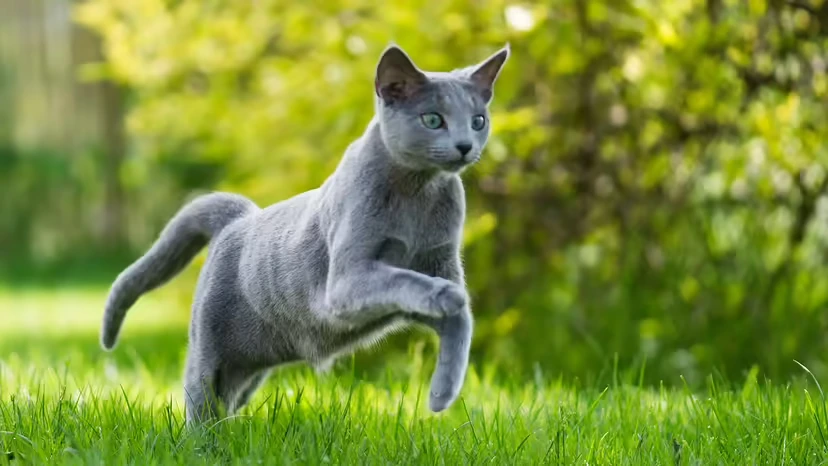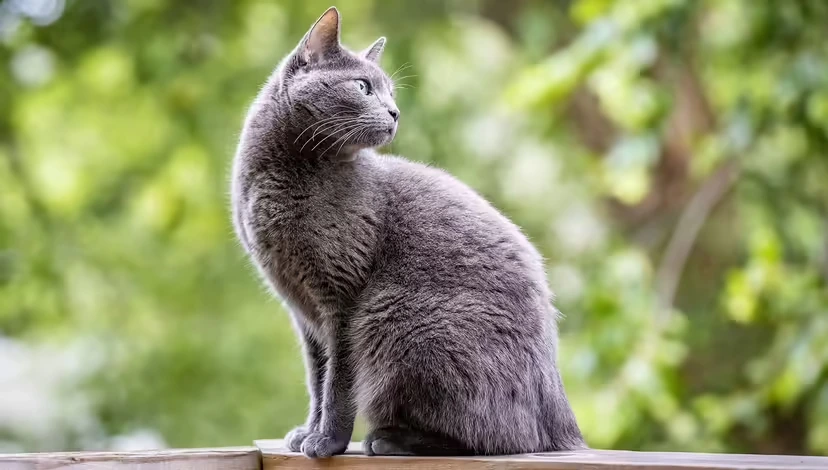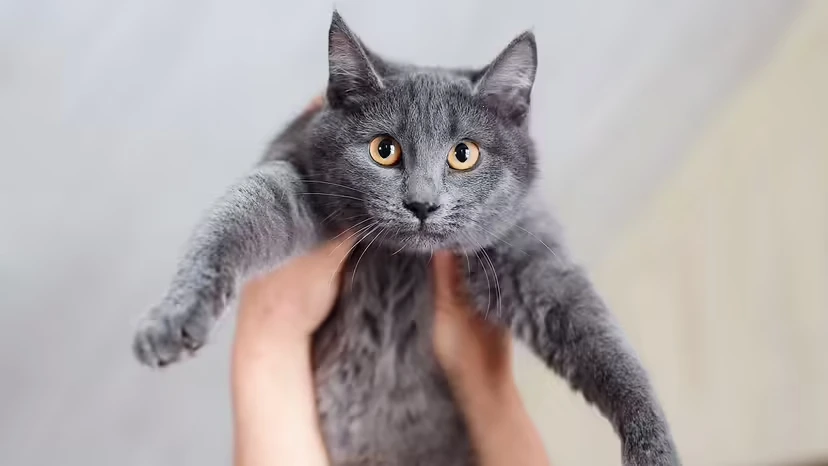TL;DR: In cat fancy, “blue” means a diluted black that reads as slate/steel gray with a cool silvery sheen. The breed most people think of first is the Russian Blue—short, dense double coat with frosted tips, vivid green eyes, and a quiet, devoted temperament.

Why “blue” isn’t blue
Look & feel: silver tipping and the double coat
Temperament & interaction
Health & grooming: low shed ≠ no brushing
Diet & body condition: a lean frame under the fluff
Allergies & the “hypoallergenic” myth
Breeding, rarity & standards
Buyer checklist (practical)
Other blue-coated cats: quick comparison
FAQ
Genetics: Two recessive dilution alleles (d/d) turn black eumelanin into slate/blue-gray.
Not one breed only: Chartreux, Korat, and British Shorthair (BSH) commonly come in blue; even mixed-breed domestic shorthairs can be blue if the genes align.
Coat structure: A true double coat—resilient guard hairs over a plush, fine undercoat—creates that “velvet pillow” handfeel.
Frosted tips: Guard hairs end in silver tipping, producing a cool metallic sheen in light.
Build: The coat makes them look stout, but the body is slender, athletic, and balanced.
Eyes: The ideal is bright emerald green. Kittens may start yellow-green and deepen with age.
ID tip: Even coloration (no tabby ghosting), cool silver cast, and paw pads/nose leather in bluish-lavender tones. The coat should feel soft yet springy, not limp.
With family: Deeply bonded, companionable, affectionate without being clingy.
With strangers/new spaces: Typically reserved/observant; appreciate hideaways and gradual introductions.
Play style: Smart and puzzle-oriented—great with wand toys, food puzzles, and fetch.
Multi-pet/kid homes: Generally compatible with slow, structured introductions and each pet’s safe zone.

Shedding: Often described as low-shedding, but seasonal molts still happen.
Routine: Brush 2–3× weekly (every other day during molts) to lift undercoat and reduce dander.
Bathing: In low-odor indoor cats, baths are infrequent; humidity control, nutrition, and antistatic care matter more.
Basics: Dental care (finger brush/gel), parasite prevention, vaccinations, and annual vet checks.
Illusion of bulk: The dense coat hides weight gain; Russian Blues should keep a defined waist/feelable ribs.
Feeding:
Set calories to ideal body weight; use scheduled meals or timed feeders.
Prioritize high-protein, moderate-fat diets with taurine and omega-3s.
Use foraging toys/snuffle mats/puzzle bowls to slow eating and satisfy hunting instincts.
Monitoring: Monthly weigh-ins + BCS (Body Condition Score).

Reality check: Cat allergies stem mainly from Fel d 1 (saliva/sebaceous proteins), not hair length or shed alone.
Russian Blue = hypoallergenic? There’s no guarantee; individual variation is huge.
Mitigation: HEPA filtration, regular brushing, laundering bedding, bedroom-free policy, and washing hands before touching your face. Test visits are wise before committing.
Rarity: Not the rarest breed, but quality lines are limited.
Reputable breeding priorities:
Even blue coat with silver tipping;
Green eyes;
Stable temperament through early socialization;
Health screening and transparent records.
Post-WWII: Lines consolidated and modern standards refined.
Registry & pedigree: Verified registration (association ID, parent info).
Health records: Vaccinations, deworming, fecal checks; basic bloodwork where available.
Socialization: Kittens 8–12 weeks with positive exposure to handling/sounds. Observe curiosity and recovery after startle.
Meet the parents: Evaluate coat quality, eye color trend, and temperament.
Contract & support: Written terms on health guarantee, spay/neuter, and breeder aftercare.
Caution: “Bargain blue cats” without documentation are often lovely blue domestic shorthairs or mixes—not the same standard or price bracket as a pedigreed Russian Blue.
| Breed | Visual vibe | Coat | Typical eye color | Temperament snapshot |
|---|---|---|---|---|
| Russian Blue | Cool silver-blue, sleek lines | Short, dense double coat with silver tipping | Emerald green | Quiet, devoted, stranger-shy |
| Chartreux | Warmish blue-gray, “smile” face | Short, slightly woolly | Copper/gold | Gentle, soft-spoken, beginner-friendly |
| Korat | Cool silver-blue, heart-shaped head | Short, close-lying | Peridot green | Alert, people-focused, needs engagement |
| British Shorthair (Blue) | Deep solid blue, round profile | Very dense short coat | Copper/gold/orange | Plush, steady, family-friendly |
Do Russian Blues shed?
Yes—less than many breeds, but they still shed and have seasonal molts. Brushing matters.
Are they good with dogs/other cats?
Usually, with gradual introductions, escape routes, and positive reinforcement.
When do eyes turn green?
Kittens may show yellow-green; the green intensifies with age, timeline varies.
Are they apartment-friendly?
Yes—if you provide vertical space (trees/shelves) and daily play to prevent boredom.
The Russian Blue’s appeal is a blend of clean, silvery aesthetics and calm, intelligent companionship. Provide predictable routines, gentle socialization, mentally stimulating play, and steady grooming, and you’ll have a quietly devoted partner for years.
animal tags: russian blue cats
We created this article in conjunction with AI technology, then made sure it was fact-checked and edited by a Animals Top editor.